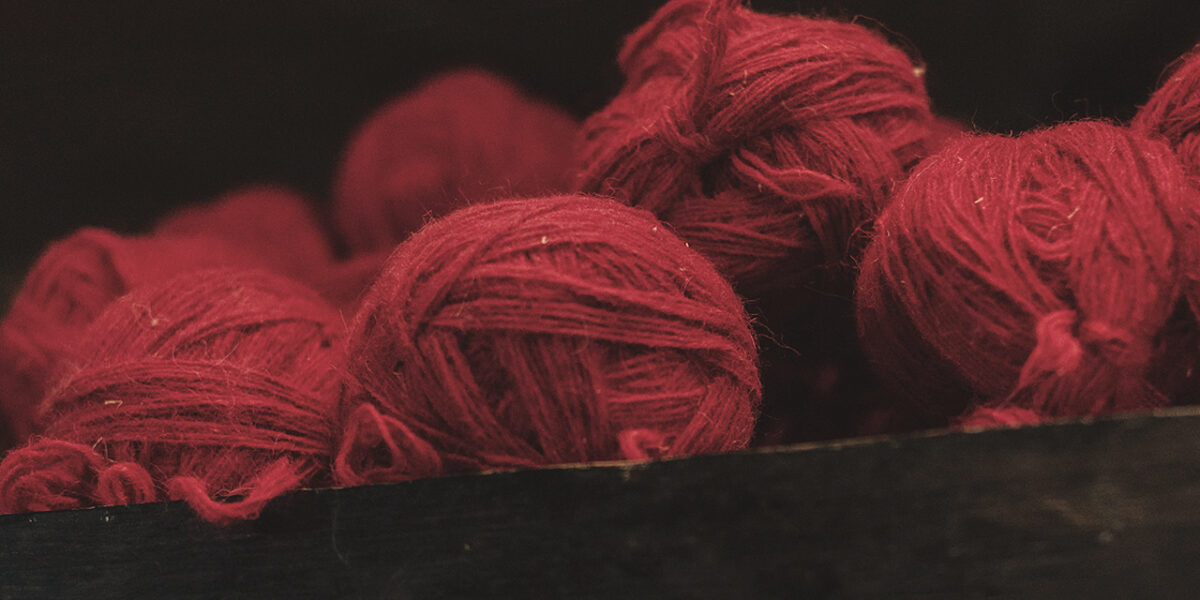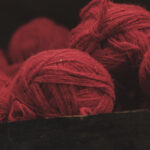The belief in an droch-shùil, the evil eye, and the charms protecting against it are perhaps the most enduring examples of Scottish folk magic, existing long after the once widespread beliefs in other aspects of magic and witchcraft had faded. Its roots lie in one of the most basic human emotions that is just as pervasive in today’s social media-driven world as it was in the simpler lives of farming folk hundreds of years ago: envy.
The ability to cast the uncannie e’e with no more than an envious gaze was thought to be handed down through the generations of a family and could be used at will, typically to damage or diminish the hard-earned possessions or loftier achievements of a more successful neighbour. Consequently it was thought prudent not to arouse envy in others in order to avoid being struck down. An old Gaelic proverb states that envy splits the rocks, as recalled by folklorist J.G. Campbell:
An industrious, careful man sold more cheese than his neighbours, and was much envied when seen, as he frequently was, on his way to market with a cheese in a bag on his back. One day, instead of a cheese, he put a small mill-stone in the bag. His neighbours, filled with envy, saw him jogging along as usual to market, and stood in their doors looking after him and making remarks. On reaching the market and opening the bag he found the mill-stone broken in two, a certain proof of the power of envy and of the truth embodied in the proverb, sgoiltidh farmad na creagan.
A malevolent glance could dry up wells, make milk and butter spoil and boats sink, and if an otherwise healthy child or animal suddenly fell ill with no underlying cause they were more likely to be suspected of being ‘overlooked’, struck down by the evil eye, than for the ailment to be chalked up to more rational medical issues. Folklorist Robert Maclagan, writing in 1902, states:
It will be easily understood that to a believer in the Evil Eye mere modern science, as met with in daily life, in doctors, and veterinary surgeons, is of small account. A well-educated lady, a friend of the writer, advised a neighbour whose cow was ill to send for the vet. The answer was, “Cha’n eil vet a chumfeum sam bith oir ‘san a tha bho air a cronachadh. ‘S e rud is fearr eòlas faotainn air a son!” “A vet is no use whatever, because the cow is air a cronachadh; the best thing is to get eòlas for it.”
From the Gaelic meaning knowledge, the eòlas was a charm of curing. There was an eòlas for everything from toothache to jaundice, and of course for the evil eye: the eòlas cronachaidh.
For those thought to have had a blink o’ the ill e’e, it was believed that their affliction could be cured by transferring the resulting malady to another object via direct physical contact. Most commonly this would be lengths of thread or yarn, an t-snàithnean, wrapped and knotted around the affected area and left there until it had healed or the threads had worn out. The threads, having had the affliction transferred to them, would then be removed and buried or burned, often being split into pieces beforehand, thus splitting the curse and ensuring its destruction along with the destruction of the physical object.
This eòlas was so widely known that when the evil eye was suspected the first suggestion would be to faigheamaid snàithnean thuige – get a thread to it.
As a country that was reared on the textile industry, it should come as no surprise that Scotland has a rich history of superstition and folklore involving thread. Readily available, almost always to hand, and easily attached to human or beast, the use of threads in this context is a perfect example of the simplicity and the ‘use what you have’ principle that typifies Scottish folk magic.
A widely recorded method of curing a cow that had been overlooked was to hold a red thread between the middle finger and thumb of the right hand – the forefinger should never be used as this was believed to be the finger that Eve used to pluck the fruit from the Tree of Knowledge – and wind it around the thumb, middle finger, and ring finger of the left hand, interestingly shaping the hand into the now familiar apotropaic gesture used to ward off the evil eye. Once wound, the thread was knotted and brought to the lips while a charm was muttered over it, and the whole process was repeated three times in total, with some sources stating that a ‘small piece of burning stick’ should be passed three times through the loop formed by the thread. The cow was then rubbed down from horn to rump, and the knotted threads tied to the cow’s tail. As the cow’s condition improved, the knots were removed and burned one by one.
Another eòlas cronachaidh was to walk through a garland of thread or pass a loop of yarn over an affected animal or child three or nine times, before cutting the loop into nine pieces and burying it.
When a child was considered to not be thriving, several threads were knotted together and tied three times around the child’s neck until they showed signs of improvement, at which point the threads were removed and thrown onto the fire. A similar method was applied to cure strep throat.
To cure ‘sleepy fever’, the patient’s left sock was rolled around a thread before being passed widdershins around the sufferer and each member of the family in complete silence. Once this process was complete, the thread was burned and the fever assumed to be cured.
As a cure for insomnia, a red thread was worn around the head for nine nights before being burned.
To get rid of warts, knots were tied in a length of thread, one for each wart, and the thread was then buried. As the knots decayed, the warts faded.
In Dundee, a skein of thread was worn around the waist or hips to ease lumbago, and single threads were worn around the temples to calm headaches.
In all cases, the person using an t-snàithnean could be absolutely certain that the ailment was caused by the evil eye if they yawned while applying the threads.
The eòlas an t-sìochaidh, or wresting thread, was used to cure sprains, dislocations and fractures. The practitioner tied nine knots evenly along a length of thread, being careful not to make any noise or to allow the thread to touch the ground at any point. The knotted thread was then tied around the affected body part while intoning a verse quietly enough for it not to be heard by any onlookers. The verse varies from place to place but its most basic form is the following:
Bone to bone, sinew to sinew
Flesh to flesh, and blood to blood.
This will make any wrested beast hale.
A more unusual variant of the verse, found on Orkney, states:
Nine knots upon this thread.
Nine blessings on thy head.
Blessings to take away thy pain,
and ilka tinter (every trace) of thy strain.
The thread is left on the affected area until it’s worn out, or is removed and destroyed once the injury has healed.
Many variants of these verses invoke figures from the Christian church, like this one from Loch Broom, translated from the original Gaelic:
Christ went forth in the early morn
and found the horse’s legs broken across.
He put bone to bone, sinew to sinew,
flesh to flesh, and skin to skin,
and as He healed that, may I heal this.
From the Western Isles, this charm is recited three times as a thread with three knots is wound around the afflicted area.
I call the Virgin Mary and St Bride to witness
That if your hurt was caused by man,
Through ill-will,
Or the evil eye,
Or a wicked heart,
That you [insert name] may be whole,
While I entwine this about you.
In the name of the Father, Son, and Holy Ghost
And this charm, collected in Alexander Carmichael’s Carmina Gadelica, was also used in conjunction with knotted threads:
I appeal to Mary, aidful Mother of men;
I appeal to Bride, foster-mother of Christ omnipotent;
I appeal Columba, apostle of shore and sea;
And I appeal to heaven, To all saints and angels that be above:
If it be a man that has done thee harm,
With evil eye,
With evil wish,
With evil passion,
Mayst thou cast off each ill,
Every malignity,
Every malice,
Every harassment,
And mayst thou be well forever,
While this thread goes around thee,
In honour of God and of Jesus,
And of the Spirit of balm everlasting
The line between religion and folk magic in Scotland was a hazy one. These verses originate from a time before Christianity was widespread in the country, but as is so often the case they were syncretically adapted over time to better reflect the teachings of the church. The intent and the method of application remain the same but the appeal is now directed towards deities from Celtic Christianity, with the Holy Trinity, Saint Bride, and Saint Columba appearing frequently. The repeated use of the number three and its multiples in threads and knots are also thought to be connected to the Trinity, though Robert Maclagan notes:
The magic thread with the knots on it … is not a superstition introduced with Christianity. It is as native as the heather of our hills, or the sandstone rock of the Coronation Stone.
The colour red has been associated with protection for centuries. The Romans hung pieces of red coral around children’s necks to protect them from danger, and the use of red string as a talisman to ward off the evil eye dates back to biblical times. Although red is the vastly predominant colour of the threads used in both curative and preventative charms, uses of blue or green threads or threads matching the colour of the animal being treated are also found.
Occasionally the red thread is braided with black and white threads into a cord, which Celtic scholar Anne Ross notes is symbolic of the Trinity:
The colours were: black, symbolic of the condemnation of God; red, symbolizing the crucifixion; and white, in representation of the purification of the spirit.
Some sources suggest the colour is completely irrelevant, and the action of knotting and tying the thread is what’s important. Robert Maclagan provides an interesting snippet of information that suggests it was the alum used in the dyeing process that was the active component of thread charms, rather than the resulting colour of the thread:
The eòlas operator first asked for yarn in which alum had been used in the dyeing. Our informant explained that it was necessary that any yarn to be used should have had alum applied to it, and as alum is always used in dyeing red (as a mordant), red is very generally what is taken on such occasions.
Amulets made of alum are used to dispel the evil eye.
As a preventative measure, knots were used to avert an droch-shùil before it could be cast. It was thought that the malicious gaze would be drawn to trace the pattern formed by the knots, distracting it from its intended target. The Manx author W. Walter Gill notes that this practice of distraction also extended to everyday applications:
These interlaced patterns found on gravestones, crosses, swords, and elsewhere, have another humble descendant in the convolutions scrawled in whiting by the housewife about her threshold; the root idea being to intrigue the evil eye of the witch or other ill-wishing adversary and keep it out of mischief.
This practice of distracting the evil eye with a tangle of whitewash was recorded in Renfrewshire as recently as 1937.
Perhaps the oldest protective charm is the simple thread knotted around the neck, most often given to young children by their parents. A short passage written by St Audoin in the 7th century attests to its antiquity:
No Christian shall attach short strings to the neck of women or of animals, even if you see this practised by churchmen, and they should tell you that this custom is a pious one.
In the Scottish Borders, nursing mothers wore knotted threads around their necks to avert weeds and onfas, sudden fevers, and the protective threads were handed down from mother to daughter.
In the west of Scotland, to prevent nose bleeds a skein of red thread was placed around the neck with nine knots tied at the front, and to prevent whooping cough a piece of red flannel was knotted around the neck.
On the east coast, John Jack, in his Historical Account of St Monance (the fishing village of St Monans), reports:
Scarlet thread is reckoned an infallible preventative of witchcraft, and it is extremely rare to find a hook fastened to the line with thread of any other colour.
It was believed that the evil eye could make butter seize in the churn and dry up the milk of every cow in a herd, so preventative charms were frequently found in the dairy. A red thread was tied around the churn staff and milk pans, and it was customary for anyone who entered the dairy while butter was being churned to lay their hand upon the staff to show that they had no intention of overlooking it.
An old rhyme describes the protective measures of the dairymaid:
Lest witches should obtain the power
Of Hawkie‘s* milk in evil hour,
She winds a red thread round her horn,
And milks thru‘ rowan-tree night and morn,
Against the blink of the evil-eye
She knows each antidote to ply
*A Hawkie is a white-faced cow.
It was a common practice to tie red threads around the cows’ tails before turning them out to pasture, and the rowan tree, with its bright red berries, was often found used in tandem with threads in the dairy.
Rowan-tree and red thread
Make the witches tyne (lose) their speed.
Popular Rhymes of Scotland collected by R. Chambers, 1841
In Kirkudbright, branches of rowan that had been carried around the Beltane bonfire were decorated with heather and flowers, wrapped with red thread, and mounted on the lintel of the byre.
Sprigs of rowan were tied to cows’ tails, fixed to the doors of the dairy, and small lengths of rowan were wrapped with red thread and stitched into the hems of shirts and jackets. Two crossed twigs bound with red thread, reminiscent of the Ojo de Dios in Mexican folklore, were a common talisman placed above doors or on the cattle stalls, worn on clothing, and attached to cows’ ears.
The belief in an droch-shùil may have faded in modern Scottish society but the image of the eye as a warding charm has seen a recent resurgence in popularity. Shopping search platform Lyst reported a 58% increase in searches for ‘evil eye’ last year, and the symbol can now be found everywhere from fashion to homewares to jewellery. In these uncertain times when we could do with repelling as much misfortune as possible, the protective talisman of the uncannie e’e is a welcome comfort.






Natalie Clark says:
Thank you!
September 12, 2021 — 3:34 pm
Brant Thorpe says:
From “Window to the West” by Meg Bateman (of Sabhal Mòr Ostaig) and John Purser:
“The colours of the moon (black for no moon, white for the full moon, red for the moon at eclipse) are the colours associated with Brigid, the pre-Christian goddess become saint [my addition: as you’ve written here, Saint Bride]. The birds sacred to her — the oystercatchers — are called “Gille-Brìghde” in Gaelic (the servants of Brigid), because they too are black, white and red.”
October 8, 2021 — 3:52 pm